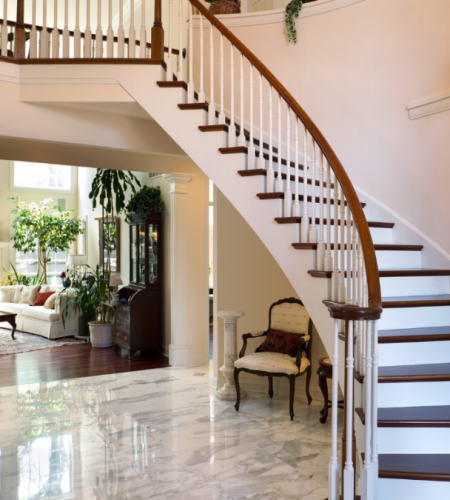A staircase is more than just a way to move between floors—it’s a critical element of both function and design in any building. Whether you’re designing for a home, office, or public space, getting the staircase right is essential for safety, comfort, and visual appeal. Good stair design blends architectural intent with engineering precision, and it’s an area where civil engineering plays a vital role.
Here are the key factors to consider when designing a staircase, explained clearly and practically.
1. Purpose and Usage of the Staircase
Before putting pencil to paper, it’s important to understand how the staircase will be used. Is it for residential or commercial use? Will it be in a high-traffic area or a private space? For example, a staircase in a busy public building needs to accommodate many people at once, while a staircase in a private home may prioritize space-saving or design aesthetics.
The purpose directly affects materials, size, layout, and safety features. In civil engineering, these user-based requirements guide all structural decisions.
2. Building Codes and Regulations
Safety is the number one priority in staircase design, and that starts with building codes. Local or national codes outline standards for things like tread depth, riser height, handrail placement, and headroom clearance. Failing to follow these rules not only risks injury—it can also lead to costly project delays or legal issues.
Codes may differ between residential, commercial, or industrial buildings. This is where civil engineering expertise is essential. Engineers ensure the design complies with regulations without compromising usability or style.
3. Stair Dimensions: Tread, Riser, and Width
Getting the stair proportions right is crucial. A staircase that’s too steep or narrow can be uncomfortable and unsafe. The three main components to balance are:
- Tread depth (the horizontal part of each step)
- Riser height (the vertical part of each step)
- Stair width (the total side-to-side space of the stair)
A good rule of thumb: the sum of one riser and one tread should be around 17 to 18 inches. Civil engineers often use formulas and modeling to optimize this ratio for different building types.
4. Material Selection
The materials you choose for a staircase affect everything—from its appearance and durability to cost and construction time. Common materials include:
- Wood: Warm and traditional, often used in homes.
- Steel: Strong and modern, suitable for commercial spaces.
- Concrete: Durable and ideal for structural staircases in larger buildings.
- Glass: Used for contemporary designs but often supported by a steel framework.
Engineers assess the load capacity and behavior of these materials under stress. Choosing the right one requires a mix of design preference and civil engineering analysis.
5. Space and Layout Constraints
A staircase must fit naturally into the building’s layout. Available space will determine the shape—straight, L-shaped, U-shaped, spiral, or custom. Tight spaces might require compact stair solutions, while open areas allow for more dramatic designs.
Proper planning ensures the stairs don’t obstruct movement or access to other areas. Collaboration between architects and civil engineers is essential here to make the most of the available footprint.
6. Structural Support and Load Bearing
Every staircase needs a solid support system. The load includes not just the weight of the staircase itself but also the people who use it. Structural stability is a core concern in civil engineering.
Depending on the design, support may come from walls, beams, columns, or cantilevered elements. Miscalculating the load capacity can lead to serious safety risks. That’s why staircases should never be built without proper engineering input, even for seemingly simple residential projects.
7. Accessibility and Ease of Use
Designing with all users in mind is not just ethical—it’s often required by law. The staircase should be easy to use for people of different ages and abilities. This includes:
- Consistent tread and riser sizes
- Comfortable handrail heights
- Adequate landing areas
- Optional visual or tactile markers for vision-impaired users
Civil engineering helps translate accessibility standards into real-world solutions that don’t compromise design.
8. Lighting and Visibility
A well-lit staircase is a safe staircase. Whether using natural light or artificial sources, make sure steps are clearly visible at all times. Shadowed or dim areas can easily cause slips or missteps.
Recessed lighting, LED strips under treads, or well-placed windows can enhance safety and add style. From a civil engineering perspective, lighting must also meet safety codes—especially in commercial and public buildings.
9. Safety Features
Beyond code requirements, there are additional features that enhance staircase safety:
- Handrails on both sides, especially for wide or public stairs
- Non-slip surfaces on treads
- Balustrades or railings to prevent falls
- Landings for rest and turning, particularly in long staircases
Safety should always be built into the design, not added as an afterthought. Engineers consider how materials behave under foot traffic, moisture, and wear over time.
10. Aesthetic Integration
While function is critical, a staircase also contributes to the overall style of a space. Is it meant to be a subtle transition between floors—or a bold architectural feature? Designers and civil engineers work together to blend form and function, choosing materials, lines, and finishes that suit the building’s identity.
An attractive staircase adds value to a home or enhances the experience in a public space. When done right, it’s both a structural necessity and a visual statement.
Final Thoughts
Staircase design sits at the intersection of creativity and engineering. A successful staircase must meet strict safety codes, serve its purpose, and fit seamlessly into the building layout. It also needs to reflect the architectural vision while accommodating practical concerns like budget, materials, and space.

